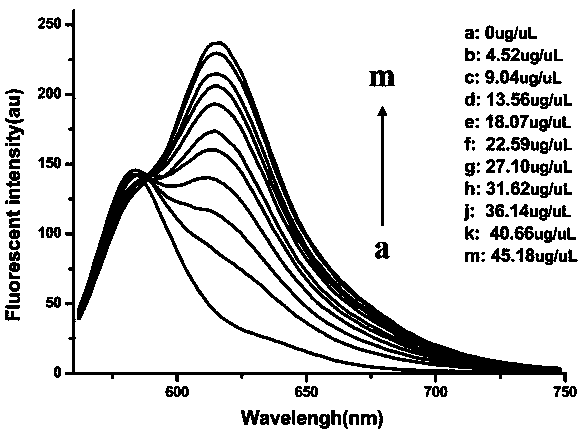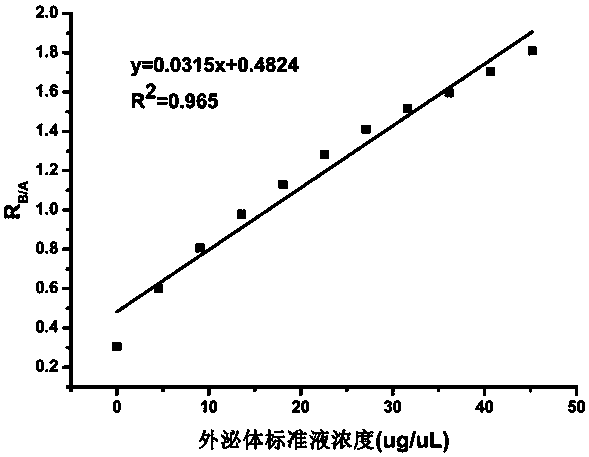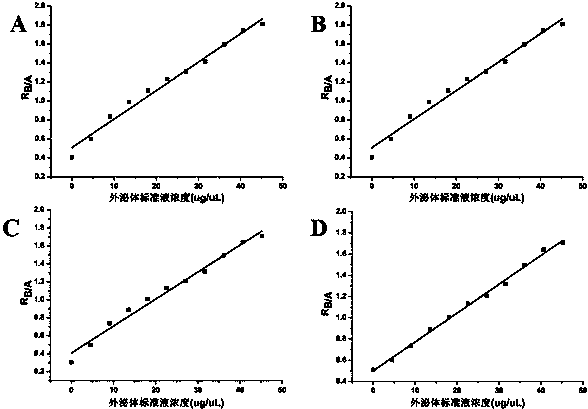Method for rapidly quantifying exosome by using fluorescence ratio
An exosome and ratio technology, applied in the field of fluorescence detection, can solve the problems of expensive experimental instruments, cumbersome experimental operations, and inaccurate results of immunoquantitative methods, and achieve the effects of convenient operation, high efficiency and low cost.
- Summary
- Abstract
- Description
- Claims
- Application Information
AI Technical Summary
Problems solved by technology
Method used
Image
Examples
preparation example Construction
[0044] Preparation of high-purity exosome standard solution
[0045] The ultracentrifugation method reported in the reference literature was used to extract and purify exosomes, treat 30mL MCF-7 cell culture medium, dissolve the exosome precipitate with 0.22μm PBS solution, and wash with PBS multiple times through a 100KD ultrafiltration tube to remove residual protein. Finally, 0.22 μm PBS was added to dissolve the exosome precipitate to obtain the exocrine standard solution. Exosome standard solution was quantified by exosome BCA protein quantification method.
[0046] Preparation of standard curve for BCA protein quantification method:
[0047] Take 0, 1, 2, 4, 8, 12, 16, and 20 μL of standard BSA protein solution (0.5 μg / μL) in sequence to prepare standards with concentrations of 0, 0.025, 0.05, 0.1, 0.2, 0.3, 0.4, and 0.5 μg / μL For BSA samples, if the sample is less than 20 μL, add PBS solution to make the volume to 20 μL. Add 200μL of BCA working solution, place at 37...
Embodiment 1
[0048] Example 1 is derived from the determination of exosome concentration in Hela cell culture fluid
[0049] 1. Preparation of exosomes from Hela cell culture medium
[0050] The ultracentrifugation method reported in the literature was used to separate and purify exosomes in Hela cell culture medium. The ultracentrifugation method reported in the reference literature was used to separate and purify exosomes, and the general experimental procedure is as follows. Hela cells were cultured in DMEM medium containing 10% exosome-depleted fetal bovine serum, 1% penicillin and streptomycin. Use 75cm 2 Cell culture flasks were cultured in a 5% CO2 incubator at 37°C to 80% confluency, collected 15 mL of Hela cell culture medium, centrifuged at 4°C, 2000g for 10 minutes to remove cell debris, and then collected supernatant and passed through a 0.22 μm filter , and the supernatant was ultracentrifuged at 100,000g for 2h at 4°C. The precipitate was retained, washed with PBS, and ce...
Embodiment 2
[0057] Example 2 is derived from the determination of the concentration of exosomes in saliva
[0058] 1. Preparation of exosomes from saliva
[0059] According to Example 1, the method of ultracentrifugation was used to separate and purify exosomes in saliva.
[0060] 2. Preparation of kit dye A, B mixed solution
[0061] Prepare the mixed DMSO master solution of dye A and dye B, dye A is A-2, and dye B is B-2. The DMSO stock solution concentration of dye A was 200 μM, and the DMSO stock solution concentration of dye B was 2 mM. The final use concentrations of dye A and dye B were 200 nM and 2 μM, respectively.
[0062] 3. Preparation of Standard Curve for Fluorescence Ratio Quantification
[0063] Take 0, 25, 50, 75, 100, 125, 150, 175, 200, 225, and 250 μL of exosome standard solution, respectively, and make the concentrations of 0, 4.52, 9.04, 13.56, 18.07, 22.59, 27.10, 31.62, 36.14, 40.66, 45.18 μg / μL exosome standard solutions. The PBS solution added to the 0.22μm...
PUM
| Property | Measurement | Unit |
|---|---|---|
| diameter | aaaaa | aaaaa |
Abstract
Description
Claims
Application Information
 Login to View More
Login to View More - R&D
- Intellectual Property
- Life Sciences
- Materials
- Tech Scout
- Unparalleled Data Quality
- Higher Quality Content
- 60% Fewer Hallucinations
Browse by: Latest US Patents, China's latest patents, Technical Efficacy Thesaurus, Application Domain, Technology Topic, Popular Technical Reports.
© 2025 PatSnap. All rights reserved.Legal|Privacy policy|Modern Slavery Act Transparency Statement|Sitemap|About US| Contact US: help@patsnap.com



